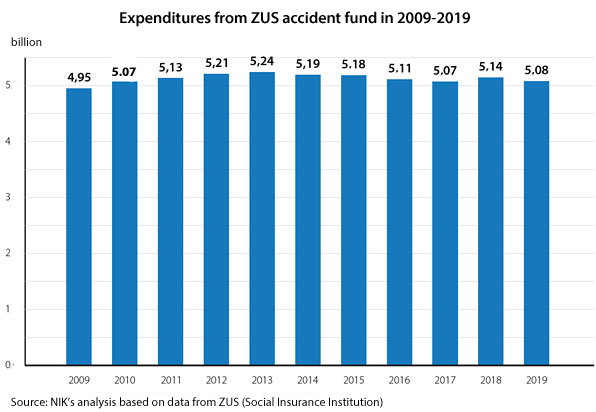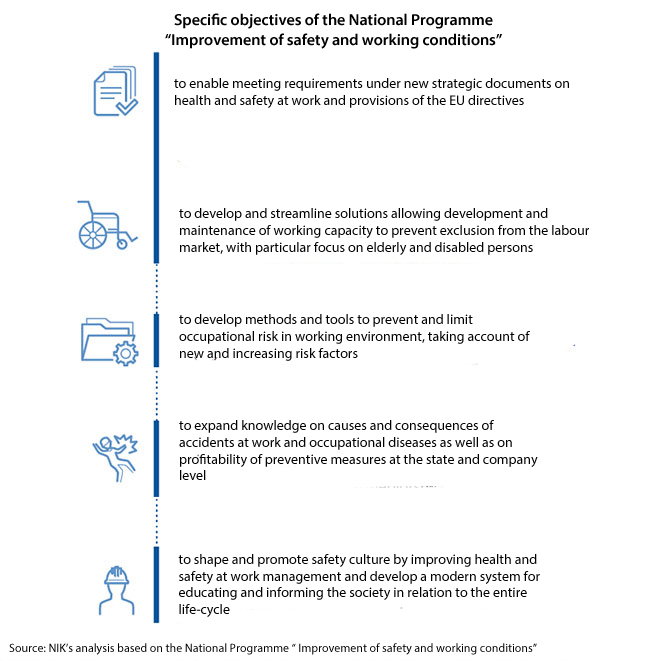The Central Institute for Labour Protection - National Research Institute (or: the Institute) conducts scientific research and development works on labour protection, health and safety at work, ergonomics and implementation of their results to eliminate or limit the causes of workplace accidents and occupational diseases. In Poland the health and safety at work standards are still lower than the ones in many EU countries. Every year about 300 people die in workplace accidents and nearly 500 thousand people work in conditions of exceeded acceptable levels of occupational exposure. In 2019, expenditures related to workplace accidents and occupational diseases totalled more than PLN 5 billion.

The National Programme for the Improvement of safety and working conditions was implemented to considerably limit the number of people working in the conditions of exposure to dangerous, harmful and arduous factors. It was also assumed to reduce workplace accidents, occupational diseases and consecutive economic and social losses and prolonged occupational activity. The Programme has been implemented since 2008 in 3-year phases. Four phases have been accomplished so far. The fifth one will be carried out in 2020-2022.

Key audit findings
In 2017-2019, the Institute carried out the total of 233 projects, of which 158 dealt with phase 4 of the National Programme. The number of research projects went down by nearly 20%, whereas the number of development projects increased by over 17%. In 2017-2019, no results of finished scientific research and development works were implemented. In that period the Institute obtained 26 invention patents and concluded 19 agreements but they dealt with projects carried out before 2017. In 2019, revenue on the implementation activity made up only 0.2% of the total revenue.
The National Programme “Improvement of safety and working conditions” included two parts:
- A – programme of task performance by state services;
- B – programme for conducting scientific research and development works.
The Programme Coordinator and the Main Contractor was the Central Institute for Labour Protection - National Research Institute. In line with the National Programme, the Coordinator’s obligations were to be laid out in agreements concluded between the Ministry of Family, Labour and Social Policy and the Institute, the National Centre for Research and Development (NCRD) and the Institute as well as the projects external contractors and the Institute. Neither the agreement between the Ministry and the Institute, nor the agreement between NCBR and the Institute defined obligations of the Institute as the Programme Coordinator. That was particularly the case with the principles and the procedure to monitor the Programme goals, for which no details or ways of performing that task were specified, e.g. data collection frequency or report types in that area. Besides, there was no separate agreement concluded with the Institute as the Programme Coordinator, which could define the principles and the procedure to monitor the Programme goals. According to NIK, the fact that the Programme Coordinator’s tasks were not specified made it impossible to evaluate if the Institute properly fulfilled that function. The Institute concluded agreements with the projects coordinators, coordinated the projects implementation, provided financing for the projects implementation to contractors and evaluated stage reports in line with the four eyes principle. Those were not obligations of the Programme Coordinator, though.
In part A of the Programme covering task performance by state services, the Institute was responsible for performing all 90 tasks. By assumption, 2031 outputs divided into 18 categories were to be produced. The total number of produced outputs was over 21% bigger than planned. The outputs were of diverse nature. Those were technical and organisational solutions supporting elimination or limitation of causes of workplace accidents and occupational diseases, guidelines, educational programmes and materials, websites, computer programmes and applications, databases, non-serial publications, scientific and popular scientific articles. The Institute prepared reports on completed phases. Planned values of the output indicators as part of the whole National Programme were achieved.
In part B of the Programme covering scientific research and development works, projects were carried out under the agreement between the Institute and the NCRD and 10 universities and scientific institutes. It was assumed that 651 outputs divided in 15 categories would be produced. The total number of produced outputs was nearly 43% bigger than planned. NIK verified the provision of 31 outputs. In three cases outputs were not produced at all. In some categories outputs were produced in excess. In four categories the number of produced outputs was exactly according to the plan. In part B of the National Programme 12 instead of 13 outputs were produced, but the planned number of produced outputs in part A of the Programme was exceeded and 22 more outputs were produced in total.
According to NIK, it is difficult to evaluate the Programme effectiveness. The indicators adopted based on data from GUS (Central Statistical Office) and ZUS (Social Insurance Institution) enable only rough estimation of losses related to poor working conditions.
NIK has pointed out that the target indicators based on GUS data measure achievement of the primary goal in an indirect way. Values achieved by individual indicators result from diverse conditions, including random factors. The Programme implementation only in part translates into the observed scope of their variability. Thus, an increase and decrease in their value does not clearly answer the question about the actual effectiveness of the Programme.
The implementation of the Programme goals (part A and B), using the adopted output and outcome indicators was monitored in an inconsistent way.
There is no documentation showing to what extent the performance of outcome indicators (illustrating changes after implementing a given initiative and situation of the project beneficiary) and impact indicators (presenting permanent changes caused by implemented projects) for phases 2 and 3 of the Programme. Thus, according to NIK, they are in fact unverifiable. Limited credibility of those indicators or their absence distorts the real picture and may result in wrong decisions.
NIK verified 20 outcome indicators to be achieved by the Institute after completing the Programme phases, by 2018. Of that 16 outcome indicators were related to phase 2 completed in 2013 and four indicators were to be met within two years after completing phase 3 of the Programme in 2016. In the projects of phases 2 and 3, nine indicators related to five projects were not achieved. The audit of 12 projects being part of phases 2 and 3 also revealed that impact indicators were not performed in none of the audited projects until 2018.
NIK has criticised the Minister of Labour, responsible for supervising the Institute and the Programme and for implementing its outcomes. In the audited period, the Minister controlled the Institute twice. He also analysed and approved the Institute’s financial statements and proposals of the net profit distribution. However, the Minister’s supervision of the Institute was not comprehensive. He did not define any principles, forms or scope of that oversight. He did not take or document any supervisory activities related to the Institute’s core activity, such as the conduct and implementation of scientific research and development works.
Also the Minister’s supervision of the Programme execution and implementation was insufficient. After completing phases 2 and 3 of the Programme (years 2011-2013 and 2014-2016 respectively) the Minister failed to evaluate the Programme impact on the achievement of the adopted indicators for individual objectives, and thus on improving safety at work and working conditions.
When it came to spending funds and developing outcomes (final results), the Minister lost his interest in the National Programme. The truth was that its outputs were to be implemented within 2 years after the Programme completion (among others for commercial purposes) and thus the outcome indicators were to be met. That, in turn, was to improve the situation in individual areas (impact indicators were to be achieved). The audit results show that a lot of projects carried out as part of the Programme were limited to developing outputs. NIK stands in a position that this points to the Minister’s weakness related to implementing the Programme results.
Recommendations
- to the Minister of Labour to:
- strengthen supervision over the Institute in terms of adapting the results of scientific research and development works to practical needs and their implementation;
- establish the principles and relations of financing projects motivating project applicants to implement the projects outcomes as well as making sure that the projects applicants comply with their obligations in that respect;
- clearly link performance indicators of the Programme to its main goal so as to enable the Programme evaluation;
- define the procedure and principles of monitoring the Programme implementation within five years after finishing its financing;
- specify tasks of the Programme Coordinator;
- develop, in consultation with the Institute, templates of relevant reports;
- document measures taken as part of the Minister’s supervision over the Institute;
- strengthen the Minister’s supervision over implementing the National Programme outcomes, including overall evaluation of the Programme by establishing clear-cut criteria and principles of evaluating the use of the Programme final results (outputs), including the achievement of the adopted outcome and impact indicators.
- to the Director of the Central Institute for Labour Protection - National Research Institute to:
- increase the use of research results in practice, which also comes down to strengthening cooperation with entities interested in using the Institute’s research results in their activity;
- review, in consultation with the Minister of Labour, applicable indicators of performance of the main goal and specific objectives so as to monitor effects of the National Programme implementation;
- make sure that agreements concluded with the Minister of Labour, NCRD and project contractors, precisely define specific objectives and related outcome indicators, to be used by the Main Contractor of the Programme, as well as other contractors.
- make sure projects contractors comply with their reporting obligations defined in the projects implementation agreements.


